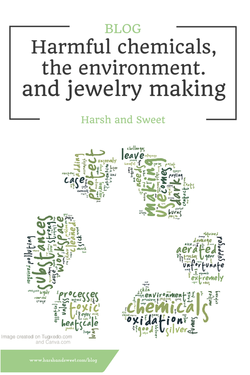|
It is very unfortunate, but making jewelry can require several extremely polluting substances. Some of them are so toxic that you are not supposed to use them unless your workspace is well aerated, as the fumes can make you sick and even cause lung damage. But even an adequate workspace will not protect you from burns, in the event that these chemicals come in contact with your skin or your eyes. Protective gear is required, and paying attention is essential. However, some of the processes used in jewelry making leave behind unseemly residues that simply must be cleaned up. The dark heatscale that coats any silver that has been melted with a torch is a case in point. Not only will it leave a dark mark on anything it touches, but it just doesn't look good. The opposite process, oxidation, also comes with its own challenges. While adding a very nice dark coloring to silver, oxidation is often obtained with liver of sulphur, a highly toxic substance. The problem then becomes how to accomplish everything that these strong chemicals can do without actually using any of them, and how to protect both the person making jewelry and the environment, which can be negatively impacted by these substances. The good news is that heatscale can be removed from metal and silver can be oxidized without any strong chemicals. Of course, both procedures entail a series of chemical reactions of one kind or another, but instead of harmful acids one can use very safe substances that we all have in the house. The process will take longer, but the advantages, in terms of safety and the environment, are worth the wait. |
Archives
May 2016
Categories
All
MonicaI love hematite, onyx, and chocolate. |
|
Copyright © 2024 Harsh and Sweet®. All rights reserved.
This website uses cookies. By continuing to use this website, you are giving consent to their use. For more information on cookies, please, visit www.google.com/privacy/partners/
|



 RSS Feed
RSS Feed














